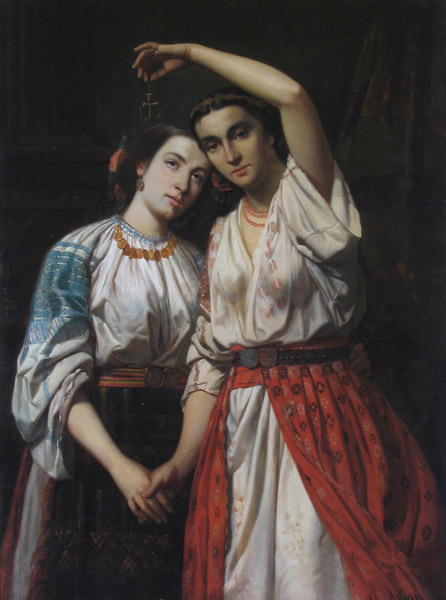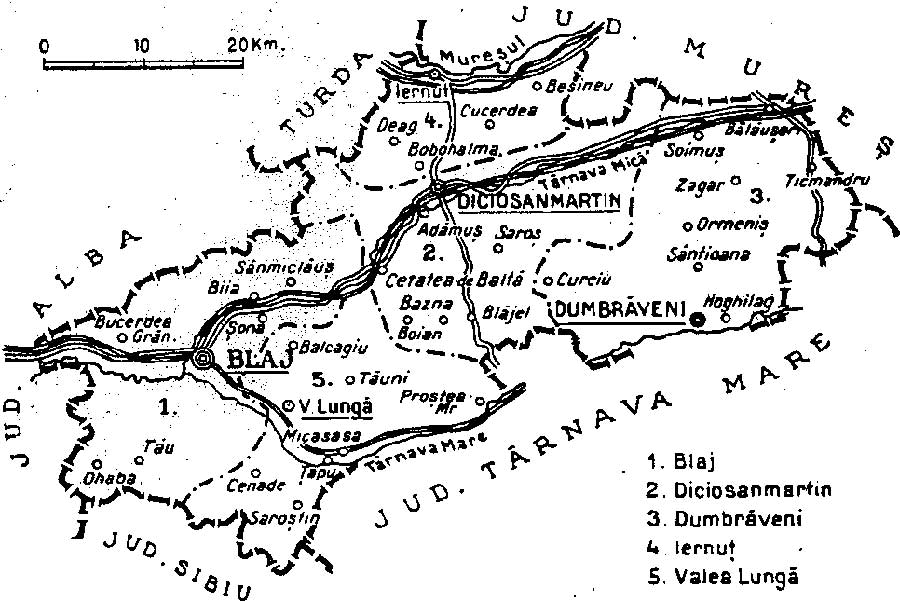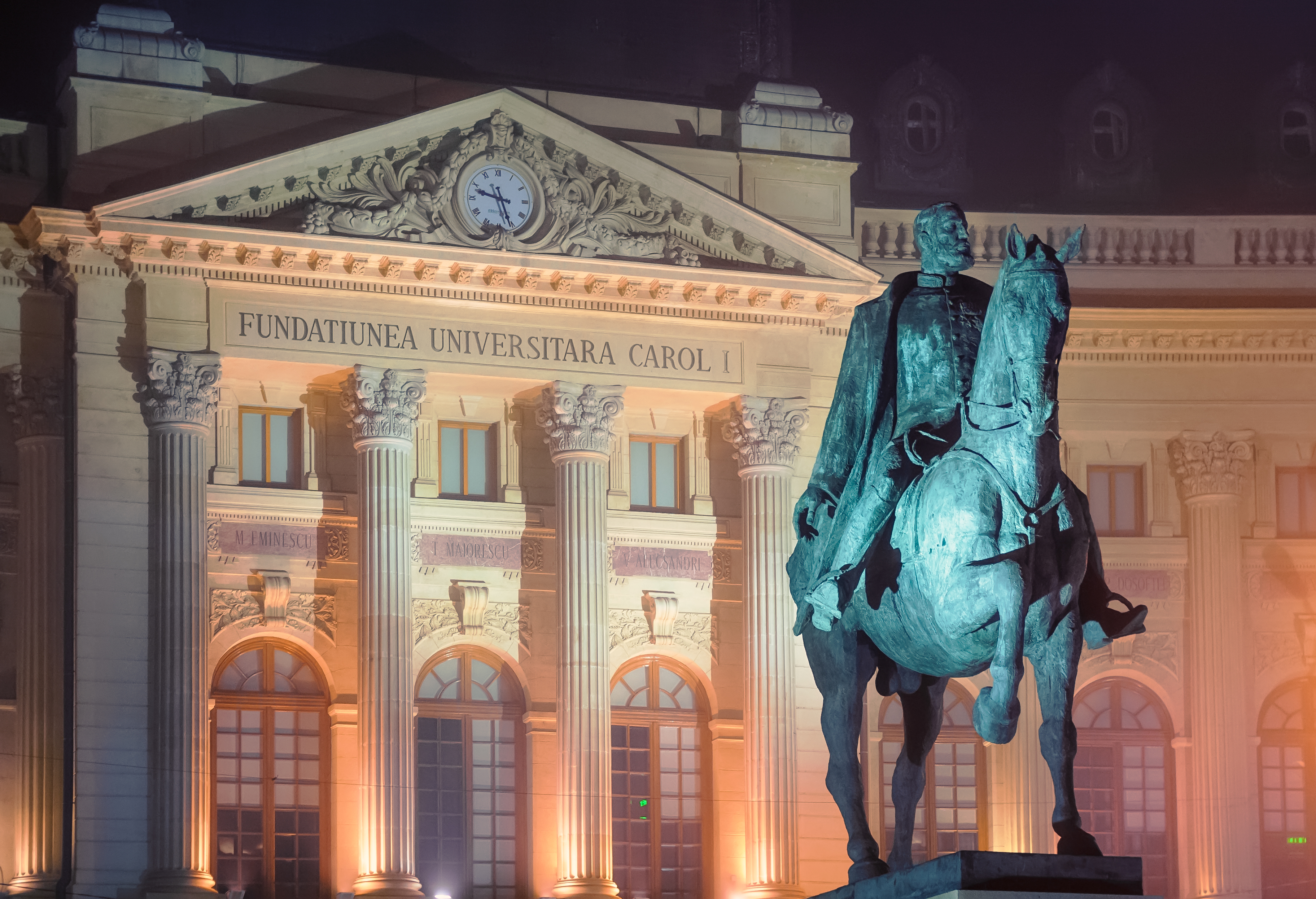|
Constantin I. Parhon
Constantin Ion Parhon (; 15 October 1874 – 9 August 1969) was a Romanian neuropsychiatrist, endocrinologist and politician. He was the first head of state of the Romanian People's Republic from 1947 to 1952. Parhon was President of the Physicians and Naturalists Society in Iași, director of medical institutes, professor, and a titular member of the Romanian Academy. Early life and education He was born in Câmpulung to the schoolteacher Ioan Parhon and his wife Maria (née Bauer). His father was originally from Cetatea de Baltă (today Alba County, formerly Târnava-Mică County). He started his secondary studies in Focșani and at the Bogdan Petriceicu Hasdeu High School in Buzău, and completed them at the Saints Peter and Paul High School in Ploiești, obtaining his baccalaureate in 1892. Parhon then went to Bucharest, where he studied medicine at the University of Bucharest from 1893 to 1900, when he obtained the scientific title of Doctor of Medicine with the thes ... [...More Info...] [...Related Items...] OR: [Wikipedia] [Google] [Baidu] |
President Of Romania
The president of Romania () is the head of state of Romania. The president is directly elected by a two-round system, and, following a modification to the Romanian Constitution in 2003, serves for five years. An individual may serve two terms that may be consecutive. During their term in office, the president may not be a formal member of a political party. The president of Romania is the supreme commander of the Romanian Armed Forces. The office of president was created in 1974 when communist leader Nicolae Ceaușescu elevated the presidency of the State Council to a fully fledged executive presidency. It took its current form in stages after the Romanian Revolution, culminating in adopting Romania's current constitution in 1991. Nicușor Dan is the 6th and current president since 26 May 2025. Communist era In the Communist era, the president was elected for a five-year term by the Great National Assembly (GNA) on the recommendation of the Romanian Communist Pa ... [...More Info...] [...Related Items...] OR: [Wikipedia] [Google] [Baidu] |
Professor
Professor (commonly abbreviated as Prof.) is an Academy, academic rank at university, universities and other tertiary education, post-secondary education and research institutions in most countries. Literally, ''professor'' derives from Latin as a 'person who professes'. Professors are usually experts in their field and teachers of the highest rank. In most systems of List of academic ranks, academic ranks, "professor" as an unqualified title refers only to the most senior academic position, sometimes informally known as "full professor". In some countries and institutions, the word ''professor'' is also used in titles of lower ranks such as associate professor and assistant professor; this is particularly the case in the United States, where the unqualified word is also used colloquially to refer to associate and assistant professors as well, and often to instructors or lecturers. Professors often conduct original research and commonly teach undergraduate, Postgraduate educa ... [...More Info...] [...Related Items...] OR: [Wikipedia] [Google] [Baidu] |
Buzău
Buzău (; formerly spelled ''Buzeu'' or ''Buzĕu'') is a city in the historical region of Muntenia, Romania, and the county seat of Buzău County. It lies near the right bank of the Buzău River, between the south-eastern curvature of the Carpathian Mountains and the lowlands of Bărăgan Plain. Buzău is a railway hub in south-eastern Romania, where railways that link Bucharest to Moldavia and Transylvania to the Black Sea coast meet. DN2, a segment of European route E85 crosses the city. Buzău's proximity to trade routes helped it develop its role as a commerce hub in older days, and as an industrial centre during the 20th century. During the Middle Ages, Buzău was a market town and Romanian Orthodox Church, Eastern Orthodox episcopal see in Wallachia. It faced a period of repeated destruction during the 17th and 18th centuries, nowadays symbolized on the city seal by the Phoenix (mythology), Phoenix bird. In the 19th century, after the end of that era, the city began to r ... [...More Info...] [...Related Items...] OR: [Wikipedia] [Google] [Baidu] |
Bogdan Petriceicu Hasdeu National College
The Bogdan Petriceicu Hasdeu National College () is a high school located at 1 Gării Boulevard, Buzău, Romania. It was named after the Romanian scholar and historian Bogdan Petriceicu Hasdeu. Founded in 1867, it is the oldest state-funded high-school in Buzău. Bogdan Petriceicu Hasdeu is a theoretical high school, with students ranging between grades 9 and 12, but it also has a small number of middle school classes. There are approximately 1,500 students aged between 11 and 19 years old. At the 2024 evaluation of all Romanian secondary schools, the high school came in 1st place, with a score of 9.58/10. History The opening and the first year (1867–1868) The law of public instruction, issued in November 1864, during the reign of Alexandru Ioan Cuza in Romania, ruled that in the country's major cities state-funded Secularity, secular high and secondary schools were to be open. In 1865, the government organized schools in several cities, leaving out Buzău, however. This decisi ... [...More Info...] [...Related Items...] OR: [Wikipedia] [Google] [Baidu] |
Focșani
Focșani (; ) is the capital city of Vrancea County in Romania on the banks the river Milcov, in the historical region of Moldavia. , it has a population of 66,719. Geography Focșani lies at the foot of the Curvature Carpathians, at a point of convergence for tectonic geologic faults, which raises the risk of earthquakes in the vicinity. Though Vrancea County is one of the most popular wine-producing regions in Romania, Odobești being just to the northwest, in Romania, Focșani itself is not considered a wine-producing center. The wine sold as ''Weisse von Fokshan'' in Germany and some other European countries is generally a ''Fetească Albă de Odobești'' wine, and practically a second-rated wine which does not comply to the European Union rules of naming the regions of origin of wines. The vicinity is rich in minerals such as iron, copper, coal, and petroleum. The city administers two villages, Mândrești-Moldova and Mândrești-Munteni. Focșani lies within the strate ... [...More Info...] [...Related Items...] OR: [Wikipedia] [Google] [Baidu] |
Târnava-Mică County
Târnava-Mică County was a county (Romanian language, Romanian: ''județ'') in the Kingdom of Romania, the successor to Kis-Küküllő County of the Kingdom of Hungary. Its capital was Târnăveni, Diciosânmartin (now Târnăveni, in Mureș County) until 1926, and afterwards at Blaj. Geography Târnava-Mică County covered 2,081 km2 and was located in central part of Greater Romania, in the centre of Transylvania. Currently, the territory that comprised the greater part of Târnava-Mică County is now part of Sibiu County, Mureș County, and Alba County. Its borders were as follows: Turda County to the northwest, Mureș County to the northeast, Alba County to the west, Sibiu County and Târnava-Mare County to the south, and Odorhei County to the east. History Prior to World War I, the territory of the county belonged to Austria-Hungary and was identical with the Kis-Küküllő County of the Kingdom of Hungary. The territory of Târnava-Mică County was transferred to Romani ... [...More Info...] [...Related Items...] OR: [Wikipedia] [Google] [Baidu] |
Alba County
Alba County () is a county (județ) of Romania located in the historic region of Transylvania. Its capital is Alba Iulia, a city with a population of 63,536. Name "Alba", meaning "white" in Latin and Romanian, is derived from the name of the city of Alba Iulia. In Hungarian language, Hungarian, the county is known as ''Fehér megye'' (fehér also meaning white), and in German language, German as ''Kreis Karlsburg''. Geography This county has a total area of , with mountains occupying about 59% of its surface. The Apuseni Mountains are in the northwest; the northeastern side of the Parâng Mountains group – the Șureanu Mountains, Șureanu and Cindrel Mountains, Cindrel mountains – are in the south. In the east there is the Transylvanian Plateau with deep but wide valleys. The three main elements are separated by the Mureș (river), Mureș River valley. The main rivers are the Mureș (river), Mureș River and its tributaries, the Târnava, the Sebeș (river), Sebeș, ... [...More Info...] [...Related Items...] OR: [Wikipedia] [Google] [Baidu] |
Cetatea De Baltă
Cetatea de Baltă (; ) is a commune in Alba County, Transylvania, Romania. The commune is composed of four villages: Cetatea de Baltă, Crăciunelu de Sus (''Christendorf''; ''Felsőkarácsonyfalva''), Sântămărie (''Frauenkirch''; ''Boldogfalva''), and Tătârlaua (''Taterloch''; ''Felsőtatárlaka''). Geography The commune is located in the northeastern corner of the county, on the border with Sibiu and Mureș counties. It is traversed by county road DJ 117, which connects it to Târnăveni, to the northeast, and to Blaj, to the southeast; the county seat, Alba Iulia, is some past Blaj. To the east it borders with Adămuș commune from Mureș County and with Bazna commune from Sibiu County, to the south and west with Valea Lungă commune, and to the west and north with Jidvei commune. Cetatea de Baltă lies on the left bank of the river Târnava Mică. The river Balta which discharges into the Târnava Mică in the village of Sântămărie. The river Tătârlaua ... [...More Info...] [...Related Items...] OR: [Wikipedia] [Google] [Baidu] |
Romanian Academy
The Romanian Academy ( ) is a cultural forum founded in Bucharest, Romania, in 1866. It covers the scientific, artistic and literary domains. The academy has 181 active members who are elected for life. According to its bylaws, the academy's main goals are the cultivation of Romanian language and Romanian literature, the study of the national history of Romania and research into major scientific domains. Some of the academy's fundamental projects are the Romanian language dictionary ('' Dicționarul explicativ al limbii române''), the dictionary of Romanian literature, and the treatise on the history of the Romanian people. History On the initiative of C. A. Rosetti, the Academy was founded on April 1, 1866, as ''Societatea Literară Română''. The founding members were illustrious members of the Romanian society of the age. The name changed to ''Societatea Academică Romînă'' in 1867, and finally to ''Academia Română'' in 1879, during the reign of Carol I. The foun ... [...More Info...] [...Related Items...] OR: [Wikipedia] [Google] [Baidu] |
List Of Members Of The Romanian Academy ...
This is a list of members of the Romanian Academy. References * Academia RomânăMembrii Academiei Române din 1866 până în prezent External links {{commons category-inline, Members of the Romanian Academy Members of the Romanian Academy Academicians Romania Romania is a country located at the crossroads of Central Europe, Central, Eastern Europe, Eastern and Southeast Europe. It borders Ukraine to the north and east, Hungary to the west, Serbia to the southwest, Bulgaria to the south, Moldova to ... [...More Info...] [...Related Items...] OR: [Wikipedia] [Google] [Baidu] |
Iași
Iași ( , , ; also known by other #Etymology and names, alternative names), also referred to mostly historically as Jassy ( , ), is the Cities in Romania, third largest city in Romania and the seat of Iași County. Located in the historical region of Western Moldavia, Moldavia, it has traditionally been one of the leading centres of Romanian social, cultural, academic and artistic life. The city was the capital of the Principality of Moldavia from 1564 to 1859, then of the United Principalities from 1859 to 1862, and the capital of Kingdom of Romania, Romania from 1916 to 1918. Known as the Cultural Capital of Romania Iași is a symbol of Romanian history. Historian Nicolae Iorga stated that "there should be no Romanian who does not know of it". Still referred to as "The Moldavian Capital", Iași is the main economic and business centre of Romania's Moldavian region. In December 2018, Iași was officially declared the Historical Capital of Romania. At the 2021 Romanian censu ... [...More Info...] [...Related Items...] OR: [Wikipedia] [Google] [Baidu] |
Carol Davila University Of Medicine And Pharmacy
Carol Davila University of Medicine and Pharmacy () or University of Medicine and Pharmacy Bucharest, commonly known by the abbreviation UMFCD, is a public health sciences university in Bucharest Bucharest ( , ; ) is the capital and largest city of Romania. The metropolis stands on the River Dâmbovița (river), Dâmbovița in south-eastern Romania. Its population is officially estimated at 1.76 million residents within a greater Buc ..., Romania. It is one of the largest and oldest institutions of its kind in Romania. The university uses the facilities of over 20 clinical hospitals all over Bucharest. The Carol Davila University is classified as an "advanced research and education university" by the Ministry of Education and Scientific Research (Romania), Ministry of Education. Created as part of the University of Bucharest in 1869, the institution is considered one of the most prestigious of its kind in Romania and in Eastern Europe. Library The university includes tw ... [...More Info...] [...Related Items...] OR: [Wikipedia] [Google] [Baidu] |







